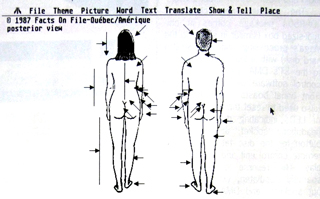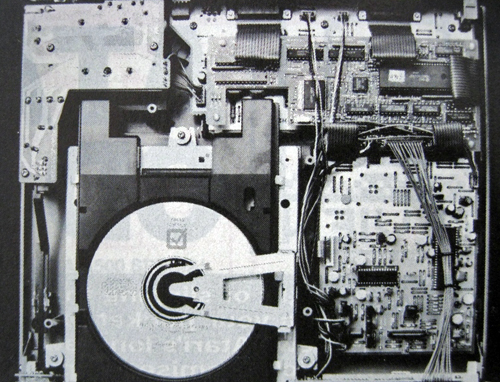
CD-ROM is like a read-only hard disk with a track length of just under three miles, capable of storing over 500,000,000 bytes of data. Huge amounts of information can be stored on a disc no wider than a handspan and whose information can be retrieved at speeds approaching those of hard disks. One thing has prevented this technology reaching home computer users sooner - price. Once again Atari's adage, Power Without The Price (®, ©, ™ etc), rings true: they have introduced a Compact Disc unit that plays both audio and ROM CDs for under £400.
The cumbersomely christened CDAR504 package comes in one midi-sized box (similar in shape to the Mega's processing unit and SH205 hard disk) with a lead for connection to the ST's DMA port, and CD and control software on 3.5'' disk. The front panel boasts a power switch (also used to reset the unit), a couple of LEDS indicating disc activity, a headphone socket, an open/close button for the disc table, a pull-out remote control unit and a digital display. The reverse is even more sparsely populated, with just audio out sockets, and DMA in and out, allowing through connection of other DMA devices like hard disks, laser printers and even other CD players).
Computer Data
CDs offer around 800Mb of storage, reduced to around 500 Mbytes if for- matted for computer data. Visually, there is nothing to differentiate between ordinary audio CDS and computer CDs - the player works out the type of disc for itself.
When connected to the ST, the CD player acts like a high-capacity hard drive. In general, CD 'seek time' (the time taken to find a file once the directory has been read) is similar to early floppy drives (remember there are over 500Mb to search through rather than 360K) and transfer rate is faster than most hard drives (153k per second). In practice it takes roughly two seconds to retrieve any piece of information.
So much for the theory, but how does the CD software and player interact with the GEM environment? Facts on File Inc's Visual French/English Dictionary was supplied with the review machine (retail machines are likely to be bundled with Grolier's Encyclopaedia, although Atari haven't finalised this yet). Software to access the CD drive is supplied on 3.5'' disk; this is simply a WIMP program, sticking to the confines of GEM, that allows you to extract data from the CD. Items can be searched for and then printed or saved as an ASCII file. The saved file can then be merged into other ASCII- accepting programs.
The disc's information is read by a laser beam produced from a gallium arsenide semi-conductor laser. An oval beam of near-infrared light is focussed to a spot of 1*m in diameter. This spot is directed towards the disc's tracks and is reflected back if it hits a space or scattered if it hits a pit.
Thus a change in the level of reflected light signals a transition from a pit to space or vice versa.
Sample - a digital 'recording' of a sound wave. The more bits of memory used to hold the sample, the better the reproduction.
Decoders – Most of have today's CD players have 16-bit decoders (they can reproduce the original sample completely). Top of-the-range players offer 18-bit resolution while the BBC manages very high quality broadcasts using only 13-bits, but keeping the broadcast equipment in top condition.
Oversampling - single samples are fed to digital-to-analogue converters (DAC) a number of times (two or four usually). This has the effect of increasing the maximum sampled frequency
The exact method in which data can be manipulated will vary from program to program. As the CD player works like a large capacity read-only hard drive, it will be possible for applications to auto boot from the player, or for the player to bring up a desktop which includes a CD player drive icon (which can be clicked on in much the same way as existing drive icons), or - like the French/English Dictionary - software on 3.5'' disk will contain the control program to extract the data.
What Software?
It's basically what Americans call a chicken and chicken situation: software houses aren't willing to invest thousands in CD-software manufacture until there's a healthy presence of CD-ROM users; few people will buy such hardware if there is next to no software support.
But maybe the situation is not that bad; Nimbus Records are producing a disc containing a massive catalogue of music, Pergamon will be releasing the International Encyclopedia of Educational some time next year and Syndromic Music are planning a library of digitised sounds which can be used with MIDI instruments. Other parties involved in CD goings-on include GST and Kuma, but they are keeping quiet about their exact plans, Hot from Atari UK comes the news that the CDAR504 can read the so-called 'High Sierra' format CDs. This means that Microsoft Bookshelf (which includes the American Heritage Dictionary, Roget 11: Electronic Thesaurus, the World Almanac and Book of Facts, and Forms ant Letters), Small Business
Consultant, Stat Pack and the like will work with appropriate GEM software in control. Currently IBM PC and PS/2 machines can run these titles: Les Player, Atari's technical director, is confident that some of Microsoft's packages will be available shortly for the ST.

The ST busy retrieving data from the visual and risque French-English dictionary on the CD-ROM.

Audio Ability
When the pleasures Of leafing through an encyclopaedia pall on you, you can always use the Atari CD ROM unit to blast out Brothers in Arms. If you don't intend listening to music through headphones then an amplifier and speakers are essential. Audio track selection is made via a remote control unit which offers start/stop, forward, reverse and first-track options. A desktop accessory provides the same choices through software.
Atari's player, in sound reproduction terms, is similar to many of the cheaper audio units available from high street outlets. CD reproduction, compared with record or cassette, is naturally of excellent quality, but unfortunately many features usually considered standard on audio-players are missing: direct-track access, repeat play, programmable track replay and favourite track selection (FTS). With this in mind, if you are intending to use the player mainly for audio purposes, you're better off with any of the Philips 4 series or Technics SL-P55O+ range.

The Atari CD ROM player looks like a normal audio CD player, and can in fact send your Dire Straits collection through your Hi-Fi if the urge takes you.
when a signal in a recording medium - be it from a magnetic tape or record groove - varies continuously and in proportion to the sound that caused it, the sound is said to be analogue. It is very difficult for the recorded signal to correspond exactly to the original sound: certain frequencies may not be reproduced properly, components can misbehave, harmonics and noise may be added. These effects may happen during recording or playback. In short, distortion occurs all too easily.
An alternative method for accurately storing sounds is to make snapshot measurements of the incoming sound waves at a high frequency' record the measurements, and on playback reconstruct the sound from those measurements. once a sample measurement is taken it can't be degraded; numbers can't decrease or increase in value unless operations are performed on them. As long as the reproducer can re-translate the stored the numbers correctly, there should be no distortion.
This digital recording technique requires that a waveform is read often enough to ensure a true representation is recorded. The sampling rate must be at least twice that of the highest frequency to prevent ‘aliasing’ (chopping on frequencies greater than half the sampling rate); in the CD’s case the sampling rate is 44.1kHz



